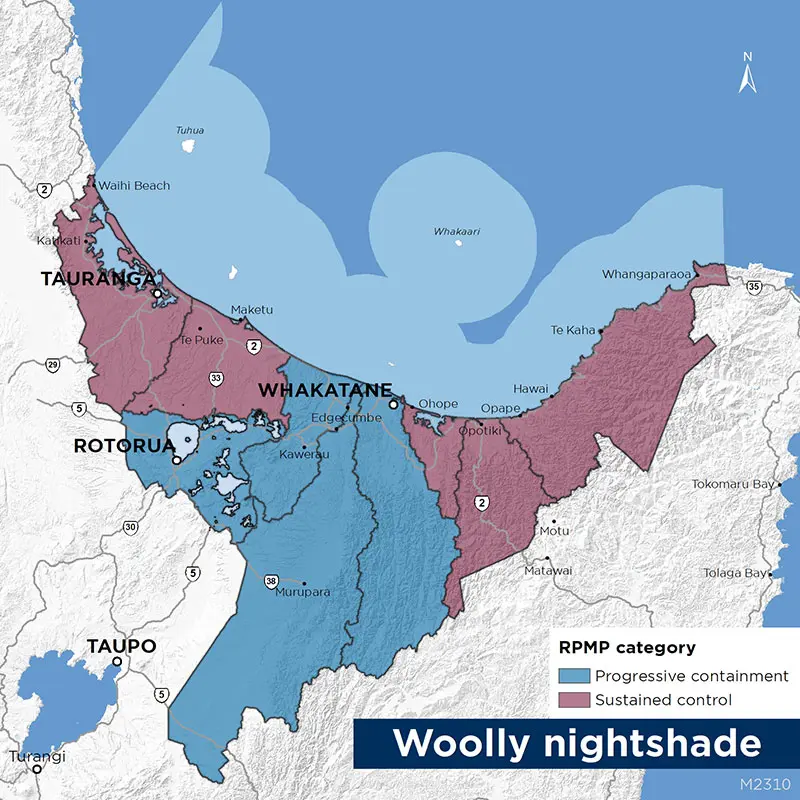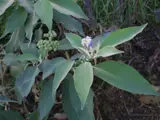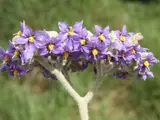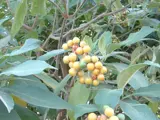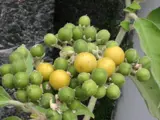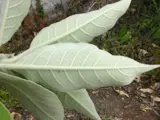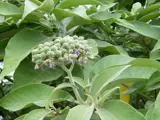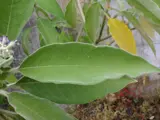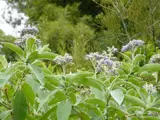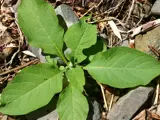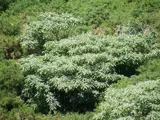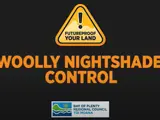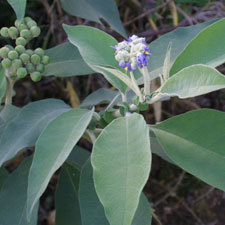 Woolly nightshade
Woolly nightshade
Common name: Woolly nightshade
Botanical name: Solanum mauritianum
Management programme: Progressive Containment, Sustained Control
Introduced to New Zealand from South America as a garden plant in 1880. Also known as tobacco weed or kerosene plant because of its strong kerosene-like smell. Woolly nightshade is allelopathic, which means it creates toxins that poison the soil preventing other plants from growing.
Why is it a pest?
- Aggressive and fast-growing, woolly nightshade forms dense stands which crowd out all other plants.
- It inhibits or prevents the regeneration rate of native forests.
- The dust from the leaves and stems can irritate the skin, eyes, nose, and throat.
- The berries are poisonous to humans if eaten, particularly children, but also to cattle and pigs.
- Vigorous growing habit, seedlings established in summer can produce seeds by autumn.
- Seeds can remain dormant in the soil and germinate up to 20-30 years later.
Where is it found?
Woolly nightshade can grow in a large range of habitats. Common areas are gullies, roadsides, neglected farms, and wasteland, along with pastoral land, disturbed forest margins, and urban areas – anywhere that birds poop!
Woolly nightshade is established and widespread throughout several areas within and surrounding Tauranga. Smaller infestations exist in eastern Bay of Plenty and the aim is to reduce these. It is very sparse in the Rotorua area and council is keen to stop it from becoming established here.
What does it look like?
- Spreading, shrub or small tree to 10m tall, with all parts covered in dusty hairs, and whitish, branching, soft-woody stems.
- Dense clusters of mauve to purple flowers year-round, followed by clusters of round berries that ripen from green to dull yellow.
- Leaves have a strong astringent kerosene like smell especially when rubbed or crushed.
What are the rules?
Woolly nightshade is both a Progressive Containment and Sustained Control species. Please see the map to determine which rules apply to your area.
Progressive containment
Progressive Containment species are pests which the Council aims to prevent from spreading, reduce the distribution, or eradicate within parts of the region over time. Landowners or occupiers are responsible for the control of Progressive Containment species on their property. Council may enforce the control of these pest species.
Sustained control
Sustained Control pests are well established in the region and preventing the spread is no longer a realistic objective. Management focuses on reducing general impacts of the pest. Landowners/ occupiers are responsible for the control of these pest species on their land. Council may enforce control.
Occupiers must destroy woolly nightshade if it is either within 200m of any property boundary where the adjoining occupier is also controlling it OR if required by a written direction from an authorised person.
How do you get rid of it?
Recommended:
Wear gloves and a mask if undertaking woolly nightshade control for extended periods.
- Manual
- Seedlings and small plants can be pulled or dug out. Larger plants that are cut down must be stump treated to prevent them from reshooting. Read our Woolly Nightshade Cut'n'paste factsheet.
- Stem frilling and injecting
- Can be done at any time of year for larger plants.
- Stump treatment
- Use at any time of the year for scattered plants.
- Basal treatment
- Using a specific basal treatment herbicide liberally paint or spray the trunk from the ground to a height of 30cm to 50cm, making sure to cover the entire trunk.
Other:
- Spraying
- This method is most suitable for smaller plants, but pulling out by hand may be cheaper and easier.
- Any time of year for large numbers of smaller plants.
- Ensure thorough coverage of the plants with a light spray.
- Aerial spraying
- Appropriate for large areas of plants.
- Seek the advice of a Land Management Officer for your situation before spraying.
- Biological control
- The woolly nightshade lacebug has been released in some parts of the Bay of Plenty. It will take some time for this to become widespread and the degree of its effectiveness is still unknown.
Follow up treatment will be required as cut stems can readily re-sprout and seedlings will continue to emerge until the seedbank is exhausted.
CAUTION: When using any herbicide or pesticide, PLEASE READ THE LABEL THOROUGHLY to ensure that all instructions and directions for the purchase, use and storage of the product, are followed and adhered to.
Read more on pest control advice, information and regulations.
Images

